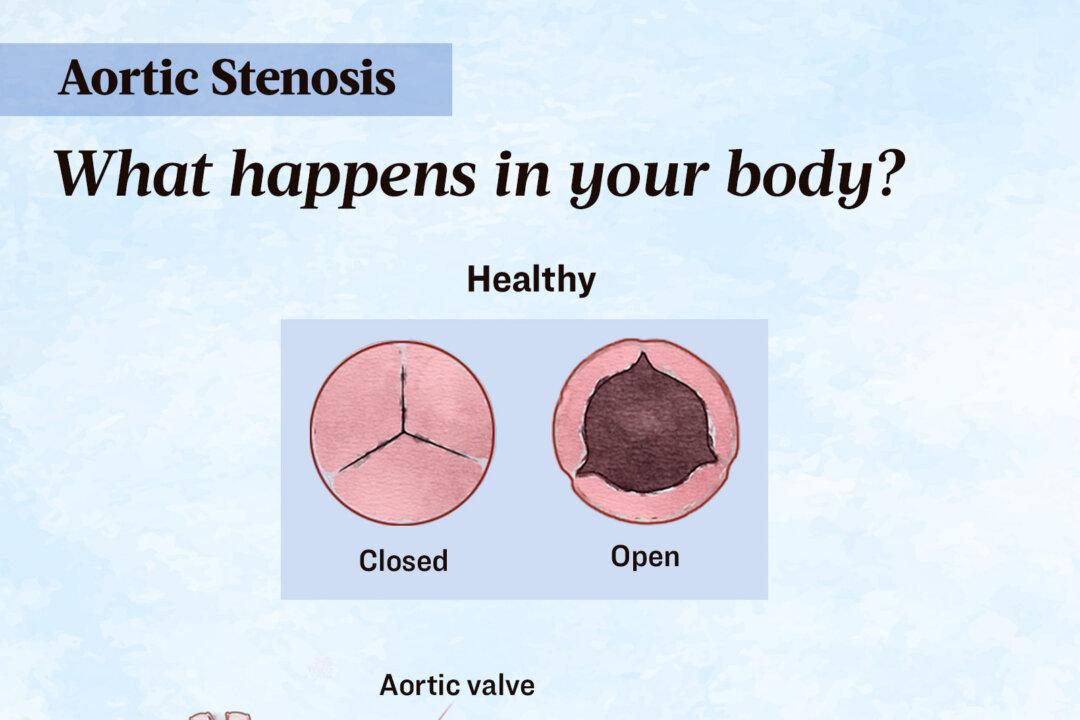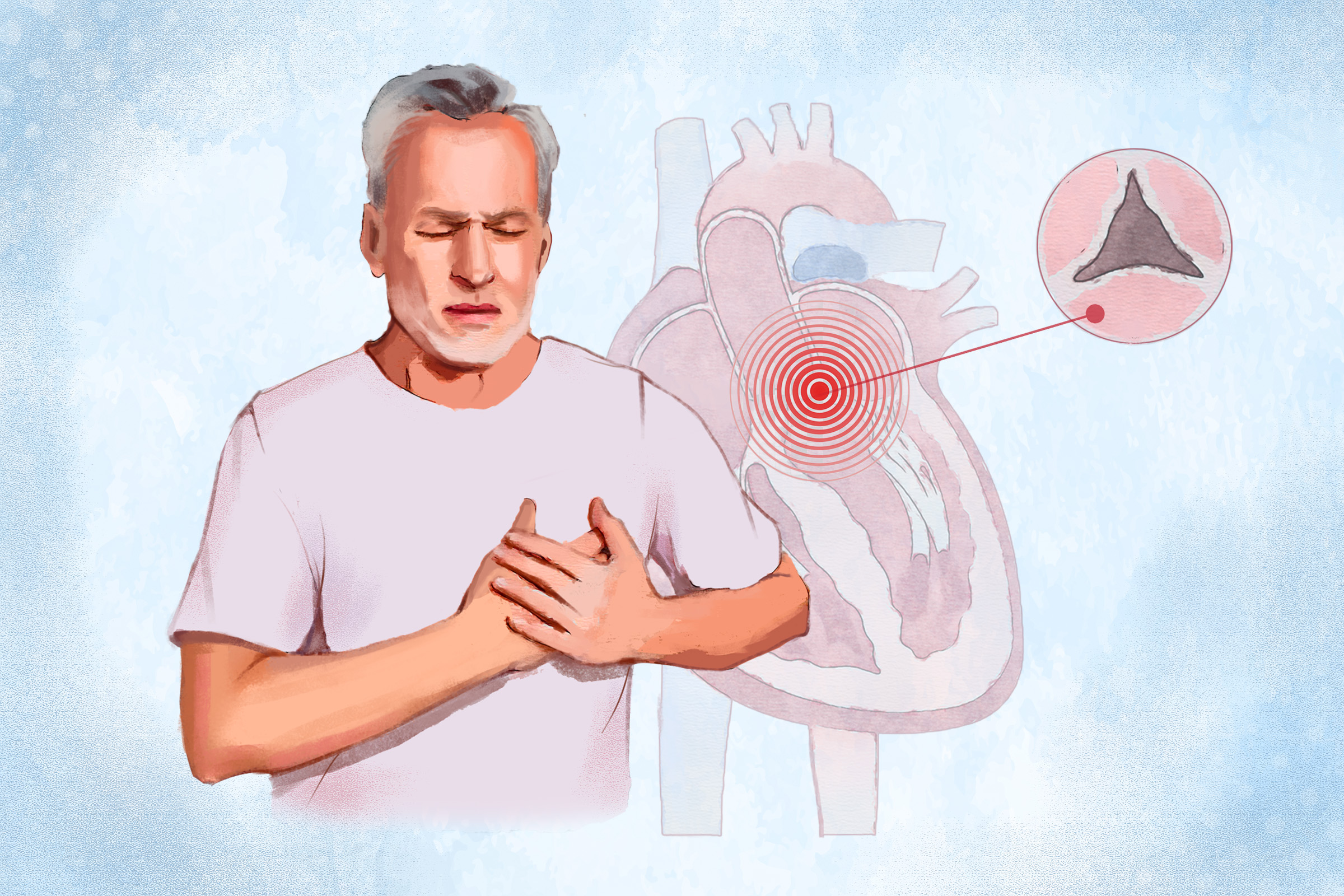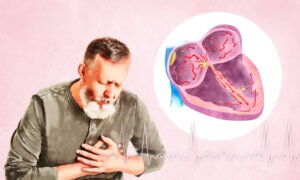- Chest pain
- Rapid, fluttering heartbeat
- Shortness of breath
- Dizziness or lightheadedness
- Difficulty walking short distances
- Swelling in the feet or ankles
- Difficulty sleeping or needing to sleep sitting up
People often dismiss these symptoms as typical signs of aging and don’t mention them during routine doctor visits. Unfortunately, waiting too long for diagnosis and treatment can cause heart damage that can’t be repaired or reversed. Severe aortic stenosis comes with a risk of sudden death, so it’s important to discuss symptoms with a primary care physician who can make a referral to a cardiologist.

Bicuspid Aortic Valve
A bicuspid aortic valve is the most common congenital heart defect, affecting approximately 1 percent to 2 percent of the population. It is more common in males than females.
Rheumatic Heart Disease
Bacterial infections, such as group A streptococcal infections and scarlet or rheumatic fever, trigger an immune response that causes inflammation throughout the body, including the heart. This can result in rheumatic heart disease. The inflammation can damage heart valves, including the aortic valve, and cause the valve to become stenotic over time.
Connective Tissue Disorders
People with autoimmune connective tissue disorders often have heart valve problems. Some of these disorders include:
- Marfan’s syndrome
- Systemic lupus erythematosus
- Rheumatoid arthritis
- Systemic sclerosis
- Sjogren’s syndrome
- Older age
- Male sex
- Congenital heart defects (bicuspid aortic valve)
- Chronic kidney disease
- Diabetes
- High cholesterol
- High blood pressure
- Infections that may affect the heart, such as rheumatic fever and infective endocarditis
- Radiation therapy to the chest
- Stage A (at risk): There are risk factors for heart valve disease present.
- Stage B (progressive): The valve disease is mild to moderate, with no current symptoms.
- Stage C (asymptomatic severe): The valve disease is severe, but there are no apparent symptoms.
- Stage D (symptomatic severe): Heart valve disease is severe and is causing symptoms.
- Electrocardiogram (ECG or EKG): An electrocardiogram is a painless test that only lasts a few minutes and measures the heart’s electrical activity. It can determine how fast or slow the heart is beating, detect irregular heart rhythms, and show patterns related to heart disease or problems within the heart chambers.
- Exercise or stress test: These tests involve riding a stationary bike or walking on a treadmill while monitoring the heart. Exercise and stress tests can help identify symptoms of aortic stenosis during physical activity. If a patient cannot exercise, medications that mimic the effect of exercise on the heart can be administered.
- Chest X-ray: A chest X-ray can show the condition of the heart and lungs. It can show an enlarged heart, which often happens with aortic stenosis. A chest X-ray can also show calcium buildup on the aortic valve or an enlarged aorta.
- Cardiac computerized tomography (CT) scan: A cardiac CT scan provides a cross-sectional view of the heart. It can accurately measure the aorta and provide a detailed view of the aortic valve.
- Cardiac magnetic resonance imaging (MRI) scan: A cardiac MRI uses magnetic fields and radio waves to create detailed heart images that can show the size of the aorta and determine the severity of aortic valve stenosis.
- Cardiac catheterization: Although this test isn’t typically used to diagnose aortic stenosis, it can help determine its severity. It can also be done before aortic valve surgery to ensure the coronary arteries (arteries in the heart) are not blocked. During a cardiac catheterization, a thin, flexible catheter is inserted into an artery at the groin or wrist and advanced into the heart. Dye flows through the catheter as X-ray images of the coronary arteries are taken.
- Heart attack
- Heart failure
- Sudden cardiac death
- Pulmonary hypertension
- Bleeding
- Infective endocarditisis
1. Medications
Milder cases of aortic stenosis without symptoms can be treated with certain medications. Although these can help control symptoms, they won’t stop the stenosis from worsening since it is a progressive disease. Medications a doctor may prescribe for aortic stenosis include:
- Blood thinners (warfarin, apixaban, rivaroxaban, dabigatran)
- Diuretics (furosemide, bumetanide)
- ACE inhibitors (lisinopril, captopril)
- Beta-blockers (metoprolol, carvedilol, atenolol)
2. Surgical Procedures
The decision to replace the aortic valve depends on severity and symptoms, age, overall health, and whether surgery is needed to repair or replace another valve or treat another heart problem. Whether to have the valve replaced with open-heart surgery or through a minimally invasive technique will depend on independent circumstances.
Balloon Valvuloplasty
This is a minimally invasive procedure to repair the aortic valve. In cases of aortic stenosis, surgeons typically prefer to replace the aortic valve rather than repair it since the valve tends to narrow again after the procedure. However, a valvuloplasty can be utilized if a patient is too ill to tolerate surgery and needs symptom relief.
Surgical Aortic Valve Replacement
A surgical aortic valve replacement (SAVR) can be done with open-heart surgery or, in some cases, using a minimally invasive robotic procedure. Open-heart surgery requires an incision in the chest and the breastbone to be opened, also called a sternotomy.
- Advantages: Mechanical valves are highly durable and are generally for younger patients because there is usually no need for repeat surgery due to valve degeneration.
- Disadvantages: There is a risk of blood clots forming with mechanical valves that could travel through the bloodstream and cause a stroke. People with a mechanical replacement valve need to be on a lifelong regimen of a blood thinner called warfarin, which comes with a higher risk of bleeding and the need for regularly scheduled blood work to make sure there isn’t too much or too little of the medication in the bloodstream.
Bioprosthetic (tissue) valves are artificial and are made of cow or pig tissue. There is no difference in the durability between the types of biological valves. Most valves have some artificial parts that give support and make them easier to put into place. The advantages and disadvantages are as follows:
- Advantages: Lifelong blood-thinning medications aren’t necessary with a tissue valve unless a person has atrial fibrillation. Tissue valves are generally a good choice for older people (60 to 70 years) because they should last their lifetime.
- Disadvantages: Although tissue valves are a more attractive alternative to many, people younger than 60 usually require repeat surgery to replace the valve since they generally only last an average of 10 to 15 years.
Transcatheter Aortic Valve Replacement
Transcatheter aortic valve replacement (TAVR) is a minimally invasive procedure that replaces a stenotic aortic valve with a tissue valve. During a TAVR, the surgeon makes a small incision in the artery at the groin and guides a thin, flexible tube through the artery and up to the heart with the new valve. Once in place, the new valve is placed inside the diseased valve, pushing the old valve out of the way as it expands and takes over regulating blood flow.
Ross Procedure
The Ross procedure doesn’t use an artificial valve. Instead, it replaces the diseased aortic valve with the patient’s own pulmonary valve and the pulmonary valve with a healthy donor valve.
- Optimism (38 percent lower risk)
- Positive outlook (32 percent lower risk)
- Having a purpose in life (27 percent lower risk)
Some practical ways to cultivate a positive mindset include the following:
- Focus on strengths rather than weaknesses
- Practice gratitude
- Focus on one’s positive qualities
- Practice self-compassion
- Practice self-care
- Shift attention away from negative thoughts
- Be more optimistic
- Practice meditation
- Set meaningful long-term goals
- Raw or cooked green leafy vegetables like spinach and kale
- Broccoli
- Brussel sprouts
- Cabbage
Some other dietary supplements that can help minimize and manage the risk of heart disease caused by increased levels of cholesterol include:
- Coenzyme Q10
- Omega-3 vitamins from fish oil
- Red yeast rice
One 2022 study determined that taking calcium supplements—whether with or without vitamin D—can worsen the progression of aortic stenosis, increase the need for aortic valve replacement in seniors, and raise mortality risk. Dr. Samir Kapadia, a Cleveland Clinic cardiologist and lead author of the study, said in the press release that people with aortic stenosis who aren’t getting enough calcium from their diet may still need to supplement calcium. Still, they should consult a doctor before starting a calcium supplement regimen.
Diet
A diet high in processed foods and sugar can contribute to aortic stenosis. Replace these with various fresh fruits, vegetables, and lean meats. Omega-3-rich foods like oily fish and flaxseed can help regulate inflammation, though evidence for whether omega-3 supplements benefit the heart is mixed. High blood pressure can also damage heart valves, so limiting foods with high sodium content and cutting down on alcohol can help lower blood pressure.
Exercise
Regular physical activity can maintain healthy blood pressure, control cholesterol, and keep blood sugar at normal levels. The Physical Activity Guidelines for Americans recommend at least 2.5 hours of moderate-intensity exercise, like brisk walking or cycling, per week. Anyone starting an exercise program should consult their doctor first, especially those with an existing heart condition.
Smoking
One in four deaths caused by heart disease can be linked to smoking. However, there is hope for people who quit. A review in the Journal of Thoracic Disease found that people who quit smoking had the same risk for heart disease as nonsmokers within 10 to 15 years.
Stress
Stress can be just as harmful to the heart as smoking. Mindfulness-focused activities like yoga, meditation, and even spending time with loved ones can keep stress in check. These activities can help lower blood pressure, fight insomnia, reduce anxiety and depression, and improve diabetes control.









